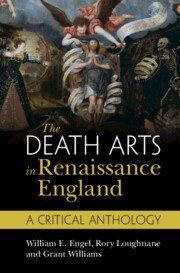"The overarching purpose of The Death Arts
is to shine a light on the disciplines, activities, and techniques dedicated to depicting dying, death, and mortalization, and to showcase how matters pertaining to gender, sex(uality), and race can inflect these representations. [...] Each of the extracts is buttressed with generous biographical and contextual information that signposts but does not steer the reader, and makes the collection an accessible entrance into the subject and its Tudor writers that will appeal to a student readership as well as a more seasoned academic one.” --The Year's Work in English Studies, “V.” (May 2024)
"Following the pattern set by their similar anthology on The Memory Arts in Renaissance England
(2016), this anthology offers a rich selection of Renaissance writings about dying, death and memorialization. ... It is a formidable challenge to select from such proliferation, but the volume offers brief and allusive excerpts, with contextualized information that in many cases is longer than the excerpt itself. Engel, Loughnane and Williams propose that the death arts can be understood through “extended mind theory”, in which “cognitive functionality” is offloaded to artefacts, techniques and language itself. ... Engel, Loughnane and Williams note that women’s 'deeply committed cultural and social engagement...with then entire death cycle' included a huge amount of practical and emotional labour. They also consider how death was sexualized and racialized in this period.
--Times Literary Supplement (Feb 10, 2023), pp. 10-11.
--Times Literary Supplement (Feb 10, 2023), pp. 10-11.
ADDITIONAL REVIEWS
"What is most significant about this anthology is its conscious location of visualizations of death within broader contemporary intellectual and cultural modes of expression. [...] Alerting us to the rich representative traditions of the Renaissance, this multifaceted character also reminds us of the ways in which different artistic forms and mediums cross-pollinate. [...] Of particular interest in this volume is the exploration of how early modern artists and intellectuals racialised notions of death. As the editors point out, any exploration of the socio-cultural exchange in the period 'almost at once runs into the issue of race and the blatant racism that permeates early modern European thought.' (36) Sensitivities to racialised language are rightly a key aspect of current critical approaches and this edition pays attention to the problematic historic linking of Blackness to evil, disease and death. In doing so, they draw attention to the ways that discourses of racial stratification, motivated by the economic and political impulses of imperial projects, permeated cultural epistemologies."
--Art History
47.1 (2024): 194-200, pp. 196-7.
Cambridge University Press publicity blog:
With the pandemic still looming above us in 2023, thoughts of passing away may have crossed your mind repeatedly over the last while. Those thoughts, revolving around a kernel of inert fear, most likely did not take hold for very long but were brushed aside and stifled with everyday urgent matters. Our culture, after all, tends to depersonalize death, making it easy for us to avoid reflecting upon the concrete finality and individuality of our own end. In this regard, Renaissance England could not have been more different from contemporary times. It made remembering death a daily, pressing matter, according to the Latin reminder memento mori (“remember that you must die”), which encouraged reflection upon the prospective event of one’s expiration. As with John Lydgate’s The Dance of Death, the basis for the mural that graced the north cloister of St. Paul’s Cathedral during the sixteenth century, it personalized an individual’s relationship with the Grim Reaper, a unique skeletal companion and final dance partner, enjoining all people—men, women, and children, from the peasant to the monarch—to imagine the future event of departing from the world.
The Death Arts in Renaissance England
(Cambridge UP, 2022), which complements our earlier volume The Memory Arts in Renaissance England
(Cambridge UP, 2016), presents a textual and visual record of how death was experienced as an art in the pre-modern sense of “artifice,” “craft,” and “techne.” Far from being an existential negation, death built up and enriched society. It was a doing, a making, a trafficking. The critical anthology has more than sixty carefully curated passages written by women and men that, along with over twenty images, consider a range of death arts practiced from 1500 to 1700, including not just the ars moriendi (the art of dying), but skills and activities as diverse as drafting wills, theatricalizing Roman suicide on the stage, analyzing numerical audits of plague victims, sermonizing from the pulpit, elegizing the nobility and royalty, composing and printing didactic murder ballads, speechifying on the scaffold, and so on. Through such activities, death can be found in the nooks and crannies of everyday early modern material culture and its archive. The death arts, by no means confined to the final drawing of the curtain, were conducted throughout a person’s entire lifetime from daily reflection on the self and dutiful commemoration of others, through preparatory labours and business, to dying, funeral, burial, and memorialization.
Where these arts were concerned, religio-political strife always rested close to the surface insofar as the Reformed church repudiated the Catholic doctrine of Purgatory and forbade intercessory prayers and rituals for the dead. The vibrancy and ubiquity of the death arts may in part be linked to the Protestant and humanist mobilization of the printing press, while English Catholic practices still lingered on. Death cavorted to different tunes across a range of popular genres, such as elegiac verse; devotional works; primers; moral philosophy and medical treatises; commonplace books; conduct manuals; repentance pamphlets; and narrative poetry, romance, and histories. Indeed, there were many ways of dancing with Death in the English Renaissance.


